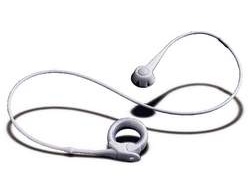Lap-Band touted as effective alternative to gastric bypass surgery

Lakeland, FL
Obesity is a nationwide epidemic in the United States.
LAP-BAND surgery, with a device like this, is much less risky and not as invasive as gastric bypass.
Additional heath problems associated with obesity compound the problem. Usually, an improved diet along with regular exercise can reverse this trend. When diet and exercise are not enough to lose weight, however, surgery might be an answer.
Gastric bypass surgery has been the most common type of weight-loss surgery.
The purpose is to give the patient a satiated feeling more quickly. To do this, a portion of the small intestine is bypassed, so fewer calories are digested and absorbed. This allows the patient to lose weight, but it is major surgery and carries certain associated risks.
Possible setbacks could come from infection of the incisions or a leak from the stomach into the abdomen, which can result in peritonitis. There is also a potential for gallstones problems to develop. Recovery can take as long as six weeks.
Another procedure that offers similar results is much less invasive and dramatically reduces patient recovery time.
Laparoscopic Louxen-Y - or Lap-Band - surgery is much less risky and not as invasive as gastric bypass, said Dr. Ravindra Mailapur, a bariactric surgeon practicing in Huntsville, Ala.
The Lap-Band is made of silastic - a brand of flexible silicone - and is implanted around the upper part of the stomach. This creates about a 1-ounce pocket, dividing the stomach into two parts. This restricts the amount of food allowed to pass into the stomach, creating a sense of fullness and reducing the caloric intake, thereby allowing the patient to lose weight, Mailapur said.
"The Lap-Band comes in a variety of sizes and can be adjusted by way of a port that is implanted below the skin," he said.
Mailapur said to qualify for Lap-Band, you must have a body mass index, or BMI, of at least 40 or a BMI of 35 if you have two or more health problems related to your weight.
The advantages of the Lap-Band surgery over gastric-bypass are many.
Lap-Band is a restrictive-type surgery and can be done by laparoscopy, a procedure that uses smaller incisions and is conducted usually on an outpatient basis. The results are less tissue damage, shorter operating times and quicker recovery periods. It is adjustable, so can be manipulated laparoscopically to make the stomach larger or smaller as the patient loses weight.
There is, however, a down side - the risks.
"Any time you perform surgery, there are risks involved, and Lap-Band surgery is no different," Mailapur said. "After all, you are introducing a foreign body into the patient."
Potential problems can include infection, the kinking of the Lap-Band and the band moving out of place, he said, in which case the band must be removed. To reduce such risks, it's important to select a surgeon who regularly performs this type of surgery and who works out of a facility with multiple specialties.
The gastric band was developed and patented in Sweden in 1985. The Lap-Band procedure came about in Europe in 1993. It has been readily available throughout Europe and since 2001, has had approval from the Food and Drug Administration for use in the United States.
Labels: gastric bypass surgery alternatives, Lap-Band surgery

0 Comments:
Post a Comment
<< Home